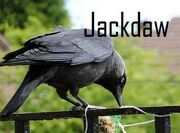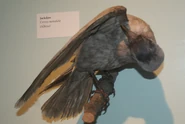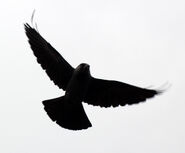what happens to female jackdaws that do not find a mate?

Jackdaw- By Erik Paterson
The Jackdaw (Corvus monedula), sometimes known as the Eurasian Jackdaw, is a dark-plumaged passerine bird in the crow family. It is found across Europe, western Asia and North Africa, and four subspecies are recognised. At 34–39 cm in length, it is one of the smallest species in Corvus, the genus of crows and ravens. It is a black-plumaged bird with grey nape and distinctive white irises. It is an omnivorous and opportunistic feeder, and eats a wide variety of plant material and invertebrates, as well as food waste from urban areas. The Jackdaw has benefited from clearing of forested areas and is found in farmland and urban areas, as well as open wooded areas and coastal cliffs. The diet of the Jackdaw mainly consists of seeds, insects, carrion, fruit and young birds or eggs. For most of the year they will live in mixed flocks. At the start of the breeding season, they will pair and these pairs tend to stay in colonies. The nests are built in chimneys or in holes. They will vary the amount of nesting material according to their nest site. They may occasionally use the nests of other birds. The female will lay up to six eggs in April and she will incubate theses for seventeen days. The chicks will then leave the safety of their nest a further four weeks later.
Description[]
Measuring 34–39 cm (14–15 in), the jackdaw is the second smallest species in the genus Corvus. Most of the plumage is a shiny black, with a purple or blue sheen on the crown, forehead and secondaries, and a green-blue sheen on the throat, primaries, and tail. The cheeks, nape and neck are light grey to greyish-silver, and the underparts a slate-grey. The bill and legs are black. The iris of adults is greyish- or silvery white. The iris of juvenile jackdaws is light blue, then brownish, before whitening around a year of age.
In flight, jackdaws are separable from other corvids by their smaller size, faster and deeper wingbeats and proportionately narrower and less fingered wings. They also have a shorter, thicker neck, a much shorter bill and frequently fly in tighter flocks. The underwing is uniformly grey, unlike choughs.
On the ground, jackdaws strut about briskly and have an upright posture.
Sexes and ages are alike.
Voice[]
Jackdaws are voluble birds. The call, frequently given in flight, is a metallic and somewhat squeaky, "chyak-chyak" or "kak-kak". Perched birds often chatter together, and before settling for the night large roosting flocks make a cackling noise. Jackdaws also have a hoarse, drawn-out alarm-call.
Distribution and habitat[]
Jackdaws are resident over a large area stretching from north-west Africa through virtually all of Europe, including the British Isles and southern Scandinavia, westwards through central Asia to the eastern Himalayas and Lake Baikal. They are resident throughout Turkey, the Caucasus, Iran, Iraq, Afghanistan, Pakistan and north-west India. The species has a large range, with an estimated global extent of between 1,000,000 and 10,000,000 km². It has a large global population, with an estimated 10 to 29 million individuals in Europe.
They inhabit wooded steppes, pasture and cultivated land, coastal cliffs and villages and towns. They thrive as forested areas are cleared and converted to fields and open areas.
Behaviour[]
Jackdaws are highly gregarious and are generally seen in small to large flocks, though males and females pair-bond for life and pairs stay together within flocks. Flock sizes increase in autumn and large flocks group together at dusk for communal roosting. They become sexually mature in the first breeding season, and there is little evidence for divorce or extra pair coupling, even after multiple instances of reproductive failure.
Jackdaws frequently congregate with Hooded Crows,[1]and during migration often accompany Rooks.
Like magpies, jackdaws are known to steal shiny objects such as jewellery to hoard in nests.
Feeding[]
The jackdaw forages in open areas and on the ground, but does take some food in trees.[2]Rubbish tips, bins, urban streets and gardens are also visited, more often early in the morning when there are fewer people about. Jackdaws employ various feeding methods, such as jumping, pecking, clod-turning and scattering, probing the soil, and rarely digging. Flies around cow pats are caught by jumping from the ground or at times by dropping vertically from a few metres above onto the cow pat. Earthworms are not usually extracted from the ground by jackdaws but are eaten from freshly ploughed soil.
In terms of animal food, jackdaws tend to feed upon small invertebrates found above ground between 2 and 18 mm in length. Snails, spiders and some insects also make up part of their animal diet. The jackdaw will also eat small rodents, eggs, and chicks. Jackdaws will feed on carrion, such as roadkill. The vegetable diet of jackdaws consists of farm grains (barley, wheat and oats), seeds of weeds, elderberries, acorns and various cultivated fruits.
Jackdaws practice active food sharing, where the initiative for the transfer lies with the donor, with a number of individuals, regardless of sex and kinship. They also share more of a preferred food than a less preferred food.
Breeding[]
Jackdaws usually nest in colonies with monogamous pairs collaborating to locate a nest site which they then defend from other pairs and predators most of the year.
Jackdaws nest in cavities of trees, cliffs or ruined, and sometimes inhabited, buildings, often in chimneys, and even in dense conifers. They are famous for using church steeples for nesting.
Nests are usually constructed by a mated pair blocking up the crevice by dropping sticks into it; the nest is then built atop the platform formed. This behaviour has led to blocked chimneys and even nests, with the jackdaw present, crashing down into fireplaces. Nest platforms can attain great size.
Nests are lined with hair, rags, bark, soil, and many other materials. Jackdaws nest in colonies and often close to rooks.[3]Paler than those of other corvids, the eggs are smooth, glossy pale blue speckled with dark brown, measuring approximately 36 x 26 mm. Clutches of normally 4-5 eggs, are incubated by the female for 17–18 days and fledge after 28–35 days, when they are fed by both parents.
Jackdaws hatch asynchronously and incubation begins before clutch completion, which often leads to the death of the last-hatched young. The young which die in the nest do so quickly which minimises parental investment, and hence the brood size comes to fit the available food supply. Infant jackdaws are altricial and thus are completely dependent on being fed by their parents until they fledge.
Social behaviour[]
The jackdaw is a highly sociable species outside of the breeding season, occurring in flocks that can contain hundreds of birds.
Jackdaws mate for life, and like most birds who follow this custom become engaged early in life, long before sexual maturity. First the young males of a new brood struggle among themselves to decide their individual status, and then pairing with females begins. The jackdaw female promptly upon pairing assumes the same social position of her male. His rights and restraints become her rights and restraints.
Should a female not secure a mate, then she remains the lowest ranked member of the flock in all social things. She is last to the food and last to the shelter. She is pecked by the lowliest, and snubbed by the least. Nor are there any lesser jackdaws on whom she can vent her frustration. As Lorenz related, it was one of these lowliest females that gave him much insight into jackdaw social behaviour. When a strong male returned to the flock, absent during the time of dominance struggles and male-female pairings, he quickly became the number one dominant male. He was forced to choose one of two unmated females for his mate. Instantly his new mate rocketed up the jackdaw social ladder and was able to peck others as much as she wanted, and she did. It took her a year to settle down. According to Lorenz the most significant factor of social behaviour was the immediate and intuitive grasp of the new hierarchy by each and every jackdaw. From the hour of her ascendancy, every jackdaw by oldest instinct knew his new place, and hers. She was "number one".
Jackdaws have been observed sharing food and objects. The active giving of food is rare in primates, and in birds is found mainly in the context of parental care and courtship. Jackdaws show much higher levels of active giving than documented for chimpanzees. The function of this behaviour is not fully understood, although it has been found to be compatible with hypotheses of mutualism, reciprocity and harassment avoidance.
Occasionally the flock makes "mercy killings" during which a sick or injured bird is mobbed until it is killed.
Gallery[]
Videos[]

Jackdaws
Jackdaws by Erik Paterson



